Compare Countertop Materials to Totally Transform Your Kitchen
- Published on
- 8-9 min
-
 Allaire Conte Contributing AuthorClose
Allaire Conte Contributing AuthorClose Allaire Conte Contributing Author
Allaire Conte Contributing AuthorAllaire Conte is a writer with a passion for real estate, technology, and nature. She holds her MFA in Nonfiction Writing from Columbia University and is based in Brooklyn.
At HomeLight, our vision is a world where every real estate transaction is simple, certain, and satisfying. Therefore, we promote strict editorial integrity in each of our posts.
“All I can say is that you get more offers with a kitchen that’s done,” remarks Pleasant Hill real estate agent Kevin Kieffer. With over 20 years of experience and stats like selling of 76% more homes than the average agent in his area, Kieffer would know.
When it comes to remodeling the kitchen, countertops are perhaps the most important design element, adding more beauty and interest than any other feature. New countertops average anywhere from $1,800 to $4,100 but don’t feel intimidated by the cost — buyers will find some flexibility in their budgets for a fresh and finished home.
“If I were to go ahead and buy a home that needs a $90,000 kitchen, I close, and now I gotta go find another $100,000 to finish my kitchen. However, if I walk in and that’s done, I’m willing to pay up because that’s all mortgage money now,” says Kieffer, sharing that many buyers would prefer to wrap the cost of an upgraded kitchen into their mortgage than pay cash for a remodel post-purchase.
But how do you choose the best countertop material for your kitchen or bathrooms? With the declining popularity of king granite, there’s no easy choice for a countertop replacement. Luckily, we did the heavy lifting and mined the data to bring you the insider ore on today’s most popular countertop materials.
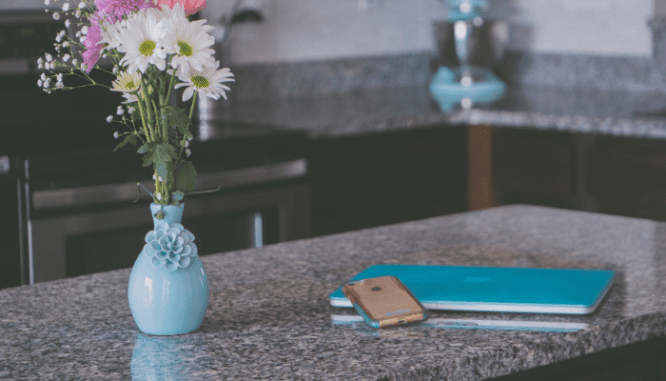
Natural stone countertop materials
A timeless and classic look, natural stone options continue to be a popular choice among homebuyers. Though natural stone varieties can be more expensive than their manufactured counterparts, these countertops are worth splurging on in any remodel. Despite a higher cost upfront, natural stone options continue to rank among the choices with the best ROI.
Granite
Cost: $40-$60 per square foot for stone slabs
Finish options:
Granite comes in a wide variety of colors and patterns. Today, homeowners prefer streaky patterns and solid slabs compared to the speckled pattern popular in the late ‘90s and early 2000s. Matte finish, or honed granite, is also on the rise along with modern styles. While honed was once only embraced in high-end markets, Kieffer says that he’s now seeing it enter mid-segment markets.
“It’s usually done on a larger slab scale … if you have a large island and a big, nice slab of honed granite, it just looks stunning.”
Material overview:
Granite is one of the hardest natural stone countertop materials, meaning it’s extremely durable, scratch, and heat resistant. It is a porous stone, though, which makes it vulnerable to staining and bacteria. To maintain an immaculate surface, reseal granite immediately upon installation and regularly throughout the countertop’s lifecycle. Just how often you will need to will vary depending on your unique slab, though. You can count on resealing at least every one to five years, but you’ll need to treat lighter varieties more regularly to prevent stains.
Marble
Cost: $40-$100
Finish options:
Like all-natural stone, marble slabs are limited to what is available in nature. Popular varieties include Calcutta and Arabescato, cherished for their light coloring and gray veining. Dark and colored varieties are also available, but these styles are less in-line with current design trends. While marble slabs are the most popular choice for countertops, marble tiles are also an option. These cost-effective options can save you 30-50% and can be laid without visible grout lines for a seamless appearance.
Material overview:
Though it is an expensive option, marble is a long-lasting stone and can be one of the most cost-effective countertops over time because of its longevity. Want to get a sense of just how long marble lasts? Consider this: The marble sculptures of the Parthenon were first carved in the early 430s B.C. and are still in pristine condition today. However, marble can be finicky and requires proper maintenance to sustain. Before marble went through the metamorphic process to become marble, it was limestone, a carbonate rock with a high calcite content.
Since calcite reacts with acids, marble is susceptible to staining and etching. You can mitigate these risks by resealing the marble every three to six months.
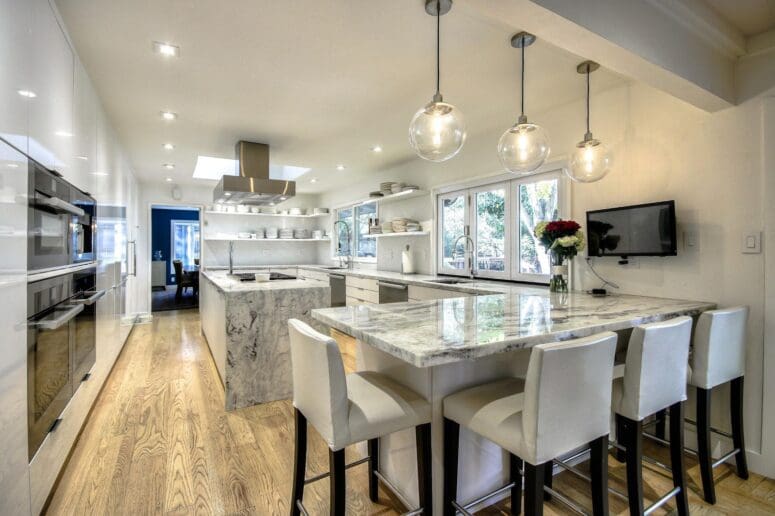
Quartzite
Cost: $50-$75 per square foot
Finish options:
Quartzite is perhaps best known as a marble look-alike; the most popular variety, Taj Mahal quartzite, resembles its namesake’s pearly marble slabs. While quartzite is available in a wide spectrum of colors, including blues and browns, the white and gray varieties that resemble marble are most in vogue today. Take note of the double waterfall island countertop made of Princess White Quartzite pictured above.
Material overview:
For those who want the toughness of granite but prefer the appearance of marble, quartzite is a worthy alternative. Like marble, these metamorphic slabs take on a veined look in various shades, from white to gray. And like granite, quartzite is a durable surface that is heat and etching-resistant. While quartzite is less porous than most other naturally occurring stones, it still needs to be sealed bi-annually to ensure its longevity and protect against stains. Just make sure to use a cutting board if you install these countertops in your kitchen — quartzite is extremely hard and will dull your knives if you prepare your mise en place directly on it.
Man-made countertop materials
In recent years, man-made countertops have fallen by the wayside while natural stones like granite and marble took center stage. But before you write off the option, know that today’s engineered countertops aren’t your grandmother’s linoleum. Advances in technology have made these countertop materials customizable, and market analysts predict that the demand for them will continue to grow. Manufactured materials range in quality, though, so make sure to do your research on the manufacturer before placing your order.
Quartz
Cost: $75-$150 per square foot
Finish options:
Quartz countertops consist of 90% ground quartz and 10% resins. Thanks to the fact that this stone is man-made, quartz is available in a wide variety of colors and patterns, with options to add marble-like veining or granite-like dappling.
“They’re all trying to mimic each other,” says Kieffer. “[Quartz] is popular because it gives you the ability to get different shades because you’re able to manipulate it.”
The National Association of Realtors reports that homebuyers currently favor contrasting colors.
Material overview:
Quartz is an engineered stone made of the mineral quartz—the same one found in the naturally occurring sibling of this countertop, quartzite. Like its sister stone, quartz countertops are extremely durable because of the natural hardness of quartz. Unlike quartzite, though, you don’t need to reseal quartz countertops annually thanks to the polymer resins. The tradeoff is that these same polymer resins make quartz vulnerable to heat discoloration. However, you can easily avoid damage by using heat-resistant trivets for any pots or pans that reach over 300 degrees Fahrenheit — and that’s just about the only maintenance you’ll need for this countertop material.
Concrete
Cost: $65-$135 per square foot
Finish options:
With nearly endless options in terms of color, thickness, shape, and size, concrete countertops rose to mainstream popularity on the coattails of the minimalism trend. Basic options for concrete countertops don’t look all that different from how the ubiquitous substance appears elsewhere: gray with a matte finish, but these countertops are highly customizable. Acid stains and dye provide a wide spectrum of colors, and veining is also an option to mimic natural stone.
Kieffer even opted for concrete in his own recent renovation: “I did concrete on my counters outside, just again, because it’s just such a nice matte finish and is really easy to work with. I could basically get whatever shade I wanted to compliment what my base was.”
Material overview:
Concrete is a popular choice for high traffic areas because of its enduring toughness. These countertops can take a beating and are extremely heat and scratch-resistant. However, they do require sustained maintenance throughout their lifespan. It is vital that you seal this countertop material properly from the start, and then reseal the countertops every one to three years. Otherwise, the material is susceptible to stains and even mold.
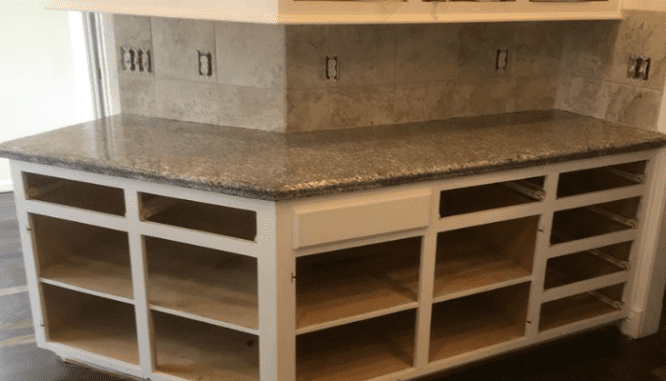
Terrazzo
Cost: $50-$100 per square foot
Finish options:
Terrazzo is a composite material marked by a confetti-like aggregate. Traditionally, the aggregate is marble chips, though today many manufacturers prefer to use recycled glass. As an engineered material, just about anything is possible when it comes to designing your terrazzo countertops. Thankfully, most manufacturers offer popular samples to help you narrow down your options.
When it comes to choosing the perfect pattern for your kitchen or bathroom, there are four factors to consider: the size of the aggregate, the color of the aggregate, the type of binder, and the color of the binder. While there are only two options for binder material, epoxy resin or cement, there are infinite combinations of aggregate and binder colors. Buyers today favor larger, Venetian aggregate and color combos that complement modern styles.
Material overview:
Terrazzo first emerged as a flooring material and was adapted for countertops because of its durability and cost-effectiveness. While it reached the height of its popularity in post-WWI America, it recently has experienced a second life alongside the resurgence of art deco and mid-century modern design — Mandy Moore even features it as a fireside bench in her Pasadena home.
Terrazzo boasts many benefits: It’s durable, scratch and stain-resistant, customizable, and, best of all, eco-friendly. Most aggregates are made of recycled glass and renewable cement and epoxy binders, making this a favorite material for LEED-certified buildings. It is a pricier option for a manufactured material, but terrazzo’s low maintenance and longevity make it cost-effective in the long run.
Recycled Glass
Cost: $65-$140 per square foot
Finish options:
Recycled glass offers as many options as its conglomerate-cousin, terrazzo. You can opt for a pattern consisting of defined glass pieces, or melt the particles together for a more uniform slab.
Material overview:
This countertop material is made of post-consumer and post-industrial recycled glass bound together with a cement or resin agent. Cement and resin-bound slab options require different maintenance, so pay close attention when choosing your countertop material base. Though this material is relatively durable, glass countertops can scratch or chip; and, when they do, you can expect a sharp surface left behind. Use stone or epoxy adhesives for a quick and easy fix to clean breaks and work out scratches with a polishing compound or jeweler’s rouge.
Laminate
Cost: $10-$40 per square foot
Finish options:
Laminate sheets cover a supportive substrate — usually plywood or MDF. While plywood is the cheaper and more durable option, it is prone to imperfections and can create an uneven surface for the laminate. MDF will give you a smoother finish, but it is especially prone to heat damage and costs as much as five times the price of plywood. Like all the man-made materials listed here, laminate styles are seemingly infinite, but faux natural stone finishes remain the most popular.
Material overview:
Laminate countertops are an affordable and DIY-friendly option. If cared for properly, they can last a decade or longer, creating an even better cost analysis. They’re even an eco-friendly product if you choose exterior grade plywood or formaldehyde-free MDF. However, this countertop material is vulnerable to harm, particularly curling laminate at the edges, chips or nicked edges, scratches, and heat damage.
Formica
Cost: $15-$40 per square foot
Finish options:
Say goodbye to the iconic boomerang pattern of the ‘50s and ‘60s, and hello to a whole new world of Formica prints. Like its parent material, laminate, Formica comes in a variety of patterns and colors. The 180fx line specializes in true-to-scale natural stone replicas and provides an affordable alternative to marble, granite, and quartzite countertops.
Material overview:
Formica is the name brand when it comes to laminate countertops — it’s even trademarked. Because it is the same material, Formica carries all of the same maintenance and durability as other laminate varieties, but with the extra pizazz of name recognition. Although there have never been more sophisticated designs available, many homebuyers still view Formica as a dated material. If you’re looking to sell your home, opting for a natural or engineered stone is a better option; but if you’re looking for a reliable and affordable surface, Formica just might be the choice for you.
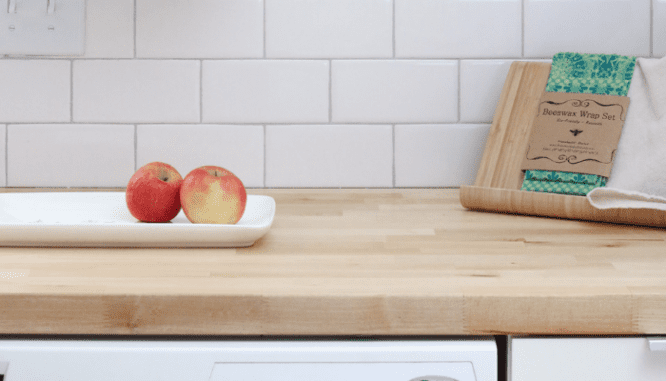
Other countertop materials
These options don’t quite fall into the man vs. nature divide of engineered materials and stone slabs, but don’t let that fool you. These countertop materials are eye-catching alternatives.
Butcher’s block
Cost: $40-$100 per square foot
Finish options:
Maple takes the cake when it comes to this baker’s favorite, with cherry, walnut, and oak ranking as close seconds. You’ll need to consider more than just wood variety to make your butcher’s block countertop *chef’s kiss* perfect, though. Woodgrain is another design factor with choices including face grain, end grain, and edge grain construction. The latter is the most popular for its durability and affordability.
Material overview:
Butcher block is formed from slabs of wood glued together, resulting in a smooth and even surface. The countertop material is often a favorite among chefs, who enjoy the material’s ideal surface for food preparation, especially kneading and cutting. Even if you’re not a gourmand, butcher’s block countertops are the perfect centerpiece for a picturesque farmhouse kitchen — a style that HomeLight agents predict will be a driving force in home buying trends for 2021.
Upkeep presents a challenge, though. Butcher’s block is susceptible to staining, heat, and water damage. To keep your counters looking fresh, you will need to sand and refinish the wood at least twice a year and take special care to treat any knicks or scratches — both to protect the wood and protect your household from bacteria that can hide in the porous surface.
Tile
Cost: Price varies depending on the type of tile used. Ceramic tiles cost $3-$4 per square foot, while porcelain tiles range from $4-$8 per square foot.
Finish options:
Options for tile countertops are as vast as the materials themselves. There is a wide selection of tile sizes, colors, and materials, as well as different grouting options. Today, porcelain slab countertops are an increasingly popular option, as they can mimic natural stone for a fraction of the price.
Material overview:
Like all things ‘80s, tile countertops are making a comeback — at least for your forever home. The versatility of tile provides the opportunity to mix and match color and texture and create offset designs which are also making a comeback in 2021. But these advantages don’t come without some drawbacks: Tile countertops are susceptible to stains and bacteria because of their porous nature. Proper installation and an epoxy grout made specifically for countertops can mitigate these risks, though. If your tile isn’t glazed, seal it according to the tile material’s specifications.
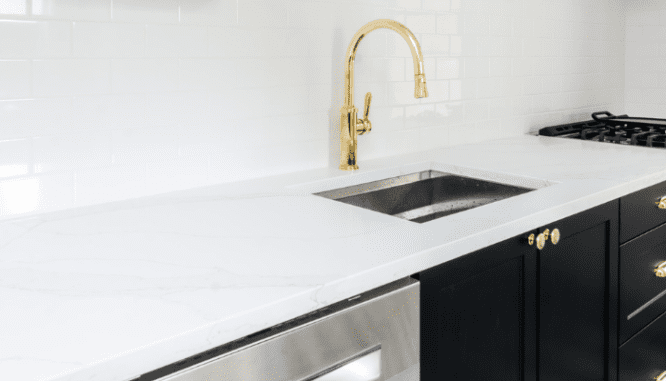
The choice is yours
If you’re feeling overwhelmed by all of the options, it’s for a good reason: There are pros and cons to each material, and it’s difficult to balance aesthetic and functionality when choosing your new countertop material. To help with this dilemma, Kieffer offers one last piece of advice:
“It’s worth the time and worth the money to have a designer come in and put [your countertop choices] together … They know exactly what works, the best way to put it together, and what’s trending.”
Even a pro like Kieffer enlists the help of these experts. “I rely on my designers,” he says. “I own several homes myself. I buy them, I fix them up, I rent them, but … I’m fixing them up ultimately to sell down the road. So I have [my designer] come in and give me all my design choices. I don’t go and make those decisions myself.”
Just like soufflés are best left to a pâtissier, your countertop material choice is in safe hands with a top designer skilled in bathroom and kitchen remodels. An expert agent can also serve as a valuable resource to determine the highest ROI materials for your area and connect you with trusted designers.
Header Image Source: (Sidekix Media / Unsplash)
